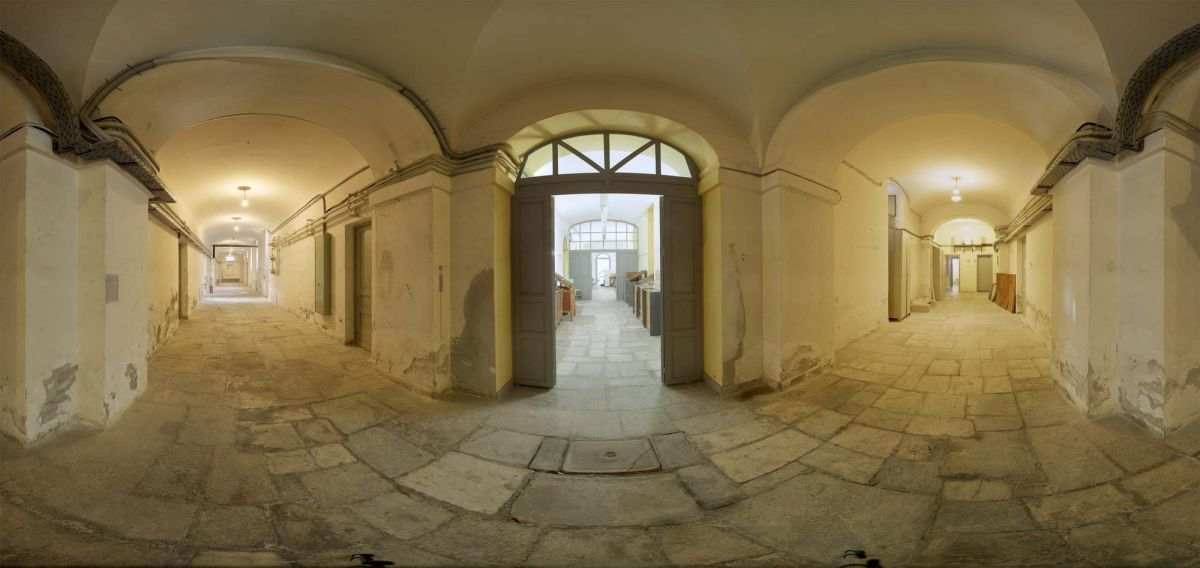CHRISTOS SIMATOS
The main theme of all these works of art is inner architectural space. The wall, the door are some of its constitutional elements. I approached it as a kind of a self-sustained existence, without aiming at any reference to its functionality. A particular and important role to the choice of the themes played the composition of the plains, as well as the texture and matiere the various surfaces acquire due to the wear of time. The photographs, seen as “portraits” of geometrical compositions, constitute one part of my quest. The second one is the panoramic views that seek to record the atmosphere of inner spaces by curving them. This illusionary function deceives the human eye, which cannot primarily recognize the space spread in front of it. Photographs can be viewed from afar but at a very small distance as well, thanks to their high resolution and the depiction of their details.
The third part aims at the cancelation of the perceptibility of material elements. A wall, a door have a coherence, a material element that defines their accessibility. Their photographic representation can record their pictorial presence but not their palpability. It creates the sense of the theme being represented, but it “is” not the theme itself. My intervention relates to some palpable criteria. Along with the palpable cancelation, a kind of optical one is at work, at the same time. The wall, once being the boundary of space, after the hanging up of the image turns to a passage, a gateway, in an illusionary way.
The process of cancelation is supplemented by the parallel sighting of the real wall and its photographic counterpart. At the installation, the photograph is divided and hang up on the wall like a jigsaw puzzle. However, it is not complete. The pieces being used are the ones recording an event, a characteristic part of the depicted space. The rest are added with the help of memory, the image is completed mentally. The fragmented image can be viewed in two ways: from a distance, connecting all the separate pieces in an undivided whole, or from up close, separating each particular piece to an autonomous picture. The relation of each image to its separate pictures, as well as to the structural elements on which it is hung, is very strong,
The fundamental core of this particular work is the relation between the familiar and the unfamiliar, the living and the dead. The familiar space, as a hospitable one, experienceable and inhabited, is contrasted to the unfamiliar, alien, dead space. The Xenia Hotel atop Mount Parnes, a once heterotopic space due to its use as a sanatorium, has long lost its utilization and is now plain ruins of the past. Heterotopic spaces/places host the kind of human activity that society seeks to put aside. The Xenia Hotel signifies society’s urge to isolate it; that is why a remote site like this was chosen to host it, in the first place. Even now, being no longer in use, its position, in combination with its deliberate abandonment, still makes it a heterotopic space/place.
In this unfamiliar environment, my pictorial quest acquires the form of an archeological research. I explore the rooms, the basements, the corridors. I record the photographic pieces of its interior. I come into contact with this unfamiliar space. Then, I go back to my studio, where I attempt a “restoration”, recomposing the space I explored before. The final image, with its panoramic elements, alters the real space, its curves it. This deformation, in combination with the depiction of the atmosphere of the particular space, bears witness to its unfamiliarity. Using the panoramic pictures from the Xenia Hotel as a structural element (whenever they are used to cover the walls of a real room), the space is transformed into an alien, unfamiliar one. Hanging them up on a surface or a wall, its perceptibility is altered. The main purpose of these installations is for the viewer to face an, up until then, alien space to him. In short, to experience the death of the particular space in such a way, that this event urges him to acknowledge the importance his familiar space has to him.


